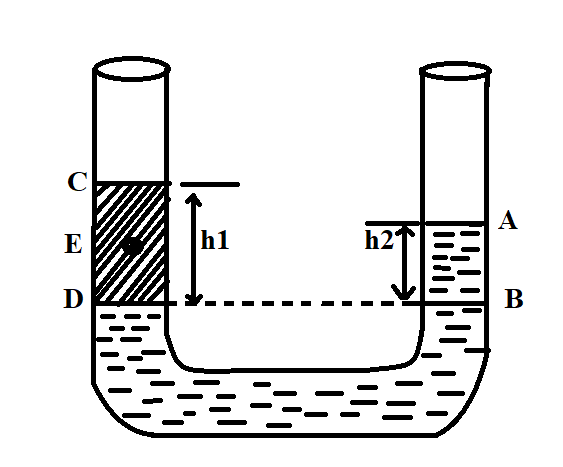
In a U-tube experiment, a column AB of water is balanced by a column CD of paraffin. The relative density of paraffin is:

A) $\dfrac{{{h_2}}}{{{h_1}}}$
B) $\dfrac{{{h_1}}}{{{h_2}}}$
C) $\dfrac{{{h_2} - {h_1}}}{{{h_2}}}$
D) $\dfrac{{{h_2}}}{{{h_1} + {h_2}}}$
Answer
147k+ views
Hint: Using Pascal’s law we get that, at the same horizontal level both fluids have the same pressure, i.e. pressure at B and pressure at D will be the same. In a confined incompressible liquid, the changes in pressure will be transmitted throughout the fluid. The pressure is directly proportional to the height and density of the fluid.
Formula used:
$P = {P_0} + h\rho g$ (where $P$ is the pressure due to the liquid, $h$ stands for the height of the liquid, $\rho $stands for the density of the liquid, and $g$ is the acceleration due to gravity)
Complete step by step solution:
According to Pascal’s law, the pressure due to two liquids at the same level will be equal. Thus we can equate the pressure due to both liquids on either side.
On the left side, the pressure is exerted by paraffin and on the right side, the pressure is exerted by water. By using Pascal’s law we can equate both.
$\therefore $Pressure at B= pressure at D
The total pressure at a point is given by the formula,
$P = {P_0} + h\rho g$…………………….
For Paraffin, the height and the density can be written as,
$h = {h_1} $
$ \rho = {\rho _p} $
For water, the height and the density can be written as,
$h = {h_2} $
$\rho = {\rho _w} $
Substituting the above values in equation (1)
${P_0} + {h_1}{\rho _p}g = {P_0} + {h_2}{\rho _w}g$
${h_1}{\rho _p} = {h_2}{\rho _w}$
Taking the ratio of densities, we get
$\dfrac{{{\rho _p}}}{{{\rho _w}}} = \dfrac{{{h_2}}}{{{h_1}}}$
Thus we can write the relative density as,
${\rho _r} = \dfrac{{{h_2}}}{{{h_1}}}$
The correct answer is option (A), $\dfrac{{{h_2}}}{{{h_1}}}.$
Note: The pressure is always acting normal to the area whatever maybe the orientation of the area. The pressure at a depth in a liquid is greater than the atmospheric pressure by an amount$h\rho g$, if the liquid is open to an atmosphere. The excess pressure at a depth h is called the gauge pressure at that point.
Formula used:
$P = {P_0} + h\rho g$ (where $P$ is the pressure due to the liquid, $h$ stands for the height of the liquid, $\rho $stands for the density of the liquid, and $g$ is the acceleration due to gravity)
Complete step by step solution:
According to Pascal’s law, the pressure due to two liquids at the same level will be equal. Thus we can equate the pressure due to both liquids on either side.
On the left side, the pressure is exerted by paraffin and on the right side, the pressure is exerted by water. By using Pascal’s law we can equate both.
$\therefore $Pressure at B= pressure at D
The total pressure at a point is given by the formula,
$P = {P_0} + h\rho g$…………………….
For Paraffin, the height and the density can be written as,
$h = {h_1} $
$ \rho = {\rho _p} $
For water, the height and the density can be written as,
$h = {h_2} $
$\rho = {\rho _w} $
Substituting the above values in equation (1)
${P_0} + {h_1}{\rho _p}g = {P_0} + {h_2}{\rho _w}g$
${h_1}{\rho _p} = {h_2}{\rho _w}$
Taking the ratio of densities, we get
$\dfrac{{{\rho _p}}}{{{\rho _w}}} = \dfrac{{{h_2}}}{{{h_1}}}$
Thus we can write the relative density as,
${\rho _r} = \dfrac{{{h_2}}}{{{h_1}}}$
The correct answer is option (A), $\dfrac{{{h_2}}}{{{h_1}}}.$
Note: The pressure is always acting normal to the area whatever maybe the orientation of the area. The pressure at a depth in a liquid is greater than the atmospheric pressure by an amount$h\rho g$, if the liquid is open to an atmosphere. The excess pressure at a depth h is called the gauge pressure at that point.
Recently Updated Pages
How to find Oxidation Number - Important Concepts for JEE

How Electromagnetic Waves are Formed - Important Concepts for JEE

Electrical Resistance - Important Concepts and Tips for JEE

Average Atomic Mass - Important Concepts and Tips for JEE

Chemical Equation - Important Concepts and Tips for JEE

Concept of CP and CV of Gas - Important Concepts and Tips for JEE

Trending doubts
JEE Main 2025 Session 2: Application Form (Out), Exam Dates (Released), Eligibility, & More

JEE Main Exam Marking Scheme: Detailed Breakdown of Marks and Negative Marking

JEE Main 2025: Derivation of Equation of Trajectory in Physics

Electric Field Due to Uniformly Charged Ring for JEE Main 2025 - Formula and Derivation

JEE Main Participating Colleges 2024 - A Complete List of Top Colleges

Degree of Dissociation and Its Formula With Solved Example for JEE

Other Pages
JEE Advanced Marks vs Ranks 2025: Understanding Category-wise Qualifying Marks and Previous Year Cut-offs

JEE Advanced 2025: Dates, Registration, Syllabus, Eligibility Criteria and More

Units and Measurements Class 11 Notes: CBSE Physics Chapter 1

NCERT Solutions for Class 11 Physics Chapter 1 Units and Measurements

Motion in a Straight Line Class 11 Notes: CBSE Physics Chapter 2

JEE Advanced Weightage 2025 Chapter-Wise for Physics, Maths and Chemistry




